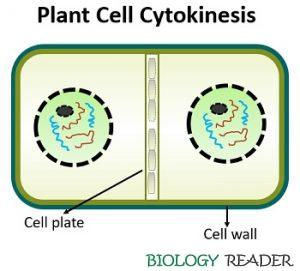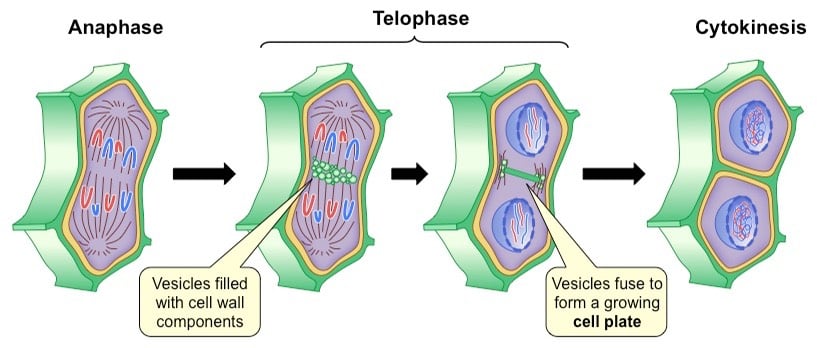how does cytokinesis differ in plant versus animal cells Cytokinesis- definition and process (in animal and plant cells)
Cytokinesis is the process through which one single cell divides into two or more daughter cells. This process differs amongst plant and animal cells, with distinct characteristics which result from the way in which cytokinesis is carried out. In plant cells, cytokinesis occurs through the formation of a cell plate. This cell plate is generated by vesicles, which combine and deposit cell wall material along the plane of cell division. This cell wall material then fuses with other elements to form a cell plate, which divides the mother cell into two daughter cells. As a result, each of the daughter cell contains a plasma membrane and a cell wall. This distinction in cytokinesis is key in understanding the differences between plant and animal cells. On the other hand, cytokinesis in animal cells takes place through the process of cleavage. At the onset of the process, a shallow groove forms around the cell, which proceeds to deepen until the cell divides. This groove is made up of a contractile ring of microfilaments, which encircle the cell. These microfilaments are composed of actin and myosin fibres, which generate the centripetal force required for the cell to split. It is clear from the above that the way in which cytokinesis is carried out varies depending on the type of cell. Whilst plant cells divide through cell plate formation, animal cells undergo the process of cleavage. Visual aids are highly effective in understanding these processes, and the following images help to clarify the differences between cytokinesis in animal and plant cells. First, let’s take a look at a typical image of cytokinesis in plant cells.
Cytokinesis in Plant Cells
 This image shows the process of cytokinesis in plant cells, whereby the cell plate separates the mother cell into two daughter cells. This is the characteristic feature of cytokinesis in plant cells, aiding in their differentiation from animal cells.
This image shows the process of cytokinesis in plant cells, whereby the cell plate separates the mother cell into two daughter cells. This is the characteristic feature of cytokinesis in plant cells, aiding in their differentiation from animal cells.
Now let’s take a look at a typical image of cytokinesis in animal cells. Cytokinesis in Animal Cells
 This image shows the process of cytokinesis in animal cells, where the cell membrane pinches inwards and cuts the cytoplasm, resulting in the formation of two daughter cells. This is the characteristic feature of cytokinesis in animal cells.
This image shows the process of cytokinesis in animal cells, where the cell membrane pinches inwards and cuts the cytoplasm, resulting in the formation of two daughter cells. This is the characteristic feature of cytokinesis in animal cells.
In conclusion, understanding the differences in cytokinesis in plant and animal cells is key in differentiating the characteristics of these two types of cells. With various visual aids, such as those presented in this post, this understanding can be developed and consolidated. If you are looking for Cytokinesis in animal cell versus plant cell. | Plant cell, Animal cell, Physiology you’ve came to the right web. We have 5 Pictures about Cytokinesis in animal cell versus plant cell. | Plant cell, Animal cell, Physiology like Difference Between Plant and Animal Cytokinesis | Compare the Difference Between Similar Terms, Cytokinesis in animal cell versus plant cell. | Plant cell, Animal cell, Physiology and also Difference Between Plant and Animal Cytokinesis (with Comparison Chart) - Biology Reader. Read more:
Cytokinesis In Animal Cell Versus Plant Cell. | Plant Cell, Animal Cell, Physiology
 www.pinterest.complant animal cell cytokinesis versus issh
www.pinterest.complant animal cell cytokinesis versus issh
How Does Cytokinesis Differ In Plant And Animal Cells : What Is Cytokinesis With Pictures / The
 buddyfromboss.blogspot.comcytokinesis cells differ
buddyfromboss.blogspot.comcytokinesis cells differ
Difference Between Plant And Animal Cytokinesis (with Comparison Chart) - Biology Reader
 biologyreader.comcytokinesis difference
biologyreader.comcytokinesis difference
Difference Between Plant And Animal Cytokinesis | Compare The Difference Between Similar Terms
 www.differencebetween.comcytokinesis similar
www.differencebetween.comcytokinesis similar
Cytokinesis- Definition And Process (in Animal And Plant Cells)
 microbenotes.comcytokinesis plant cells bioninja cell animal division process definition biology separation figure source
microbenotes.comcytokinesis plant cells bioninja cell animal division process definition biology separation figure source
Cytokinesis- definition and process (in animal and plant cells). Difference between plant and animal cytokinesis. Cytokinesis similar